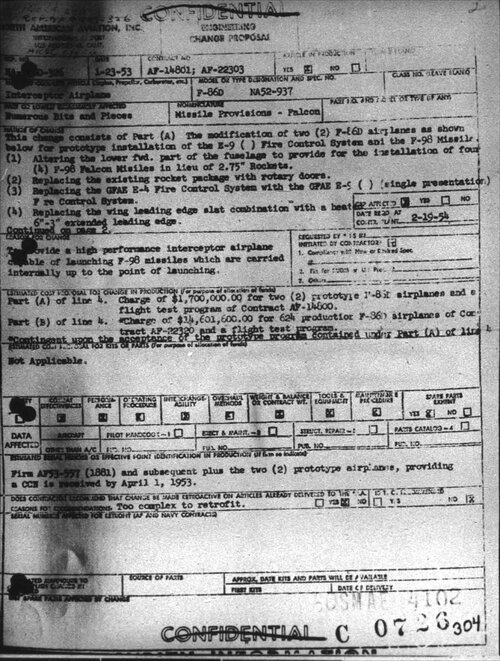As early as November 1950, North American Aviation (NAA) had proposed its “Advanced F-86D Transonic Interceptor” to USAF Air Materiel Command. Among its features, the Advanced F-86D would incorporate a low-mounted horizontal tailplane; a 45-degree swept wing, ‘Coke bottle’ area-ruled fuselage and inboard ailerons. Powerplants ranged from the ‘ultimate J47’ to Pratt & Whitney’s J57. Armament was to be a combination of up to 60, 2.75-inch FFAR rockets (and no other armament) or four MX-904 missiles and 36 FFAR rockets. The proposed aircraft would, according to NAA’s proposal, complete its first flight in early 1952 and be ready for service the following year.
It is likely that a routine line of communication was established between the AMC and its contractor for discussion of this topic, though no budget appears to have been put in place for further development under Air Force funding at that time.
Then in March 1952, NAA submitted a further study to AMC, which it continued to refine until August of that year when a less radical proposal for “MX-904 Falcon Missile and 2.75” FFAR Rocket Installation in F-86D Airplane” was proffered. This proposal was for a new-production version of the F-86D with four Falcon missiles replacing the internal Mighty Mouse complement of the standard F-86D and up to 24 of the unguided rockets now in wing packages or various other combinations. An extended ‘wet’ wing leading edge was also proposed, which would carry fuel and offset deletion of external drop tanks. A Hughes E-9A fire control system was a key component of the new F-86D proposal.
NAA proposed the conversion of two existing F-86Ds to test the Falcon installation, though modification of existing F-86Ds for the full (service use) configuration was deemed to be too complex to be worthwhile when ranged against new-build machines. North American suggested that if accepted, the revised configuration could be introduced on F-86D s/n 52-3898 (the first F-86D-45), providing agreement had been reached by 1 December 1952; a revised Engineering Change Proposal was prepared on 23 January 1953, this time proposing to introduce the configuration as a production fit from F-86D-55 s/n 53-557 so long as a contractual note had been received by 1 April 1953.
Ultimately no contract for prototype or production aircraft was set up, undoubtedly because funding was thought to be better spent on dedicated Century-series Falcon-equipped machines as well as similarly armed F-89H Scorpions in the interim.
NAA did however test the external Mighty Mouse rocket packages on s/n 52-3598 (the first F-86D-40 airframe) and the Falcons (externally) on F-86D-60 s/n 53-4061, the latter with the extended-chord wing later installed on F-86L interceptors.
It is likely that a routine line of communication was established between the AMC and its contractor for discussion of this topic, though no budget appears to have been put in place for further development under Air Force funding at that time.
Then in March 1952, NAA submitted a further study to AMC, which it continued to refine until August of that year when a less radical proposal for “MX-904 Falcon Missile and 2.75” FFAR Rocket Installation in F-86D Airplane” was proffered. This proposal was for a new-production version of the F-86D with four Falcon missiles replacing the internal Mighty Mouse complement of the standard F-86D and up to 24 of the unguided rockets now in wing packages or various other combinations. An extended ‘wet’ wing leading edge was also proposed, which would carry fuel and offset deletion of external drop tanks. A Hughes E-9A fire control system was a key component of the new F-86D proposal.
NAA proposed the conversion of two existing F-86Ds to test the Falcon installation, though modification of existing F-86Ds for the full (service use) configuration was deemed to be too complex to be worthwhile when ranged against new-build machines. North American suggested that if accepted, the revised configuration could be introduced on F-86D s/n 52-3898 (the first F-86D-45), providing agreement had been reached by 1 December 1952; a revised Engineering Change Proposal was prepared on 23 January 1953, this time proposing to introduce the configuration as a production fit from F-86D-55 s/n 53-557 so long as a contractual note had been received by 1 April 1953.
Ultimately no contract for prototype or production aircraft was set up, undoubtedly because funding was thought to be better spent on dedicated Century-series Falcon-equipped machines as well as similarly armed F-89H Scorpions in the interim.
NAA did however test the external Mighty Mouse rocket packages on s/n 52-3598 (the first F-86D-40 airframe) and the Falcons (externally) on F-86D-60 s/n 53-4061, the latter with the extended-chord wing later installed on F-86L interceptors.
Attachments
-
 520808a Falcon.jpg268.5 KB · Views: 333
520808a Falcon.jpg268.5 KB · Views: 333 -
 520808b Falcon.jpg343.9 KB · Views: 135
520808b Falcon.jpg343.9 KB · Views: 135 -
 520808c Falcon.jpg154.1 KB · Views: 107
520808c Falcon.jpg154.1 KB · Views: 107 -
 520905 Falcon.jpg259.7 KB · Views: 105
520905 Falcon.jpg259.7 KB · Views: 105 -
 520908 Falcon.jpg778.8 KB · Views: 100
520908 Falcon.jpg778.8 KB · Views: 100 -
 520908a Falcon.jpg207.9 KB · Views: 99
520908a Falcon.jpg207.9 KB · Views: 99 -
 520908b Falcon.jpg201.8 KB · Views: 96
520908b Falcon.jpg201.8 KB · Views: 96 -
 520908c Falcon.jpg292 KB · Views: 92
520908c Falcon.jpg292 KB · Views: 92 -
 530123 Falcon.jpg560.1 KB · Views: 260
530123 Falcon.jpg560.1 KB · Views: 260 -
 520908d Falcon.jpg170.4 KB · Views: 101
520908d Falcon.jpg170.4 KB · Views: 101 -
 Falcon (2).jpg57.3 KB · Views: 304
Falcon (2).jpg57.3 KB · Views: 304 -
 Falcon (3).jpg51.8 KB · Views: 388
Falcon (3).jpg51.8 KB · Views: 388 -
 Falcon.jpg40.2 KB · Views: 381
Falcon.jpg40.2 KB · Views: 381
Last edited:




